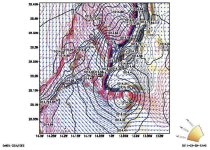Hello there,
I am working on a simulation of a multicellular storm on volcanic terrain.
The response of the land to warm you is poor (It is a volcanic area and has an important thermal inertia to warm up, in theory).
In other simulations I have done, I have managed to paint meso-low and meso-high (small areas of low pressure (hPa) appear), according to the warming of the terrain, convergences, etc and above all modify the surrounding wind or in response to these pressure structures. Can improve this part with some specific physics?..
WRF model 4.1; input data NNRP DS90.0 NCAR; simulation length 24 hours; 4 nested domains; vertical levels 35; maximum grid resolution 200 meters (not topographic); temporary resolution domain 4 of 5 minutes; physics_suite = 'CONUS';
Best regards,
L Alvarez
PD: I have attached an example of another event, where I did see small-scale structures
I am working on a simulation of a multicellular storm on volcanic terrain.
The response of the land to warm you is poor (It is a volcanic area and has an important thermal inertia to warm up, in theory).
In other simulations I have done, I have managed to paint meso-low and meso-high (small areas of low pressure (hPa) appear), according to the warming of the terrain, convergences, etc and above all modify the surrounding wind or in response to these pressure structures. Can improve this part with some specific physics?..
WRF model 4.1; input data NNRP DS90.0 NCAR; simulation length 24 hours; 4 nested domains; vertical levels 35; maximum grid resolution 200 meters (not topographic); temporary resolution domain 4 of 5 minutes; physics_suite = 'CONUS';
Best regards,
L Alvarez
PD: I have attached an example of another event, where I did see small-scale structures

